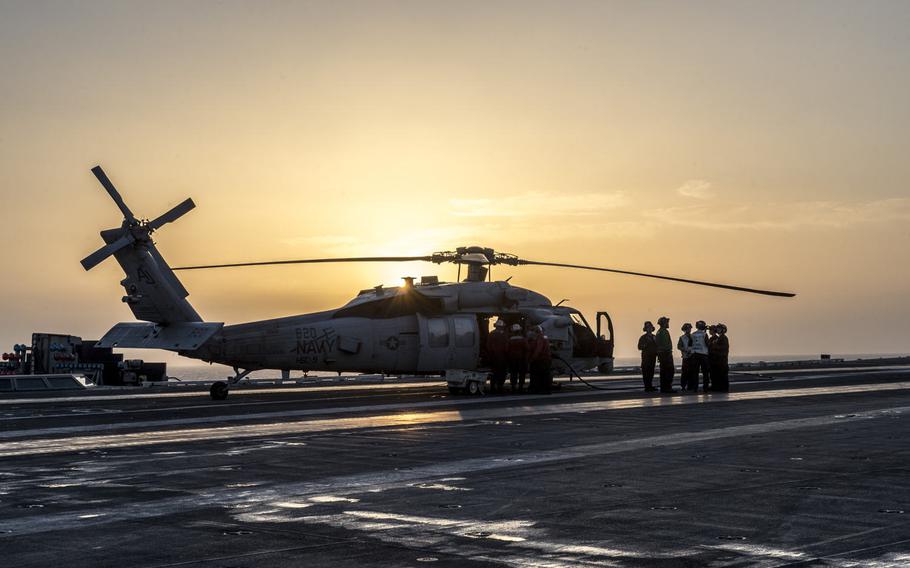
Flight deck crew onboard the aircraft carrier USS George H.W. Bush check a helicopter before take off in the Persian Gulf, April 20, 2017. (Chris Church/Stars and Stripes)
Deep below an aircraft carrier’s flight deck, where jet fighters zoom off to bomb enemy targets, engineering crews carry out the unglamorous work that’s vital to the mission and the ship’s survival.
Keeping systems is a mammoth job on a carrier, requiring crews to toil long hours in the ship’s cavernous recesses, enduring uncomfortable heat and barely seeing sunlight for weeks.
“If you did not have an engineering department, the ship would not move,” Petty Officer 3rd Class Connor Sanders, an electrician, said on the USS George H.W. Bush while it was deployed last month in the Persian Gulf.
Crews fix and maintain electrical, plumbing, and other systems and make replacement parts for the ship’s myriad metal fittings. They put out fires. And they ensure that no toxic gases endanger crew members, either from the internal systems or from an enemy attack.
The engineering crews are like an orchestra, said Lt. Cmdr. Derek Mason, damage control assistant of the Bush’s engineering department. He’s a conductor, helping the 250 sailors work together to keep the behemoth afloat and mission ready.
“It’s a big ship,” Mason said. “We have 5,000 people, and you never know what to expect when you wake up in the morning. You have many hands touching one piece of equipment. Everything is susceptible to wear and tear.”
His crews oversee high-tech equipment inside the ship that scans for gas leaks as well as biological agents and radioactivity, Mason said. External devices test for airborne poisons that an enemy might unleash.
After the sarin gas attack in Syria in early April, Mason ordered his crew members to keep a more vigilant watch on the external detectors. It was a reminder they’re deployed in a dangerous region.
The Bush is nuclear-propelled, with an on-board reactor whose steam generators produce the ship’s electricity. Mason’s teams handle utilities outside the nuclear section — everything from the water for laundry, showers and restrooms to electrical wiring for the ship’s lighting, computers and incinerator.
The department is on call around the clock.
Keeping electricity flowing all times on the ship is paramount because if the engine’s computers go down, the ship will stall, Sanders said. “I look at it as a chain reaction.”
Technicians can get so busy dealing with the constant demands that they can become like cavern dwellers who don’t go above deck for months.
“I’ve got to see the sun at least once every couple of weeks,” said Petty Officer 3rd Class Kody Kratz, a machinist, who joked he didn’t want to go pale and lose his Hawaiian heritage.
Kratz and Sanders say they work much of the time in 100-degree heat. The heat, Kratz said, provides a sauna to go with the pull-up bar and weights in his work area.
Engineering crews draw little recognition. In fact, no one seems to think of them until they need something repaired or a part replaced. Sanders and Kratz shrugged off the lack of kudos.
Helping friends on the ship who depend on their services is rewarding enough, Sanders said.
“I only care that the ship doesn’t sink,” Kratz said.
Mason believes most people on the carrier appreciate the engineering crews and know the troubles that would arise if they weren’t there to fix snafus and maintain vital systems.
“That’s a ship I wouldn’t want to be on,” Mason said.